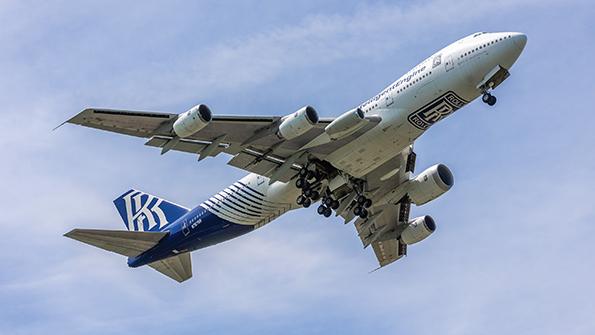
Combined RB211 and Trent 1000 power boosts the Pearl 10X—mounted on the inboard right wing—to higher altitudes.
Rolls-Royce’s highly unusual Boeing 747-200 flying testbed takes the “form follows function” design principle to a new height as part of the company’s efforts to wring out the performance of its Pearl 10X business jet engine.
Destined for Dassault’s Falcon 10X long-range flagship business jet, the Pearl 10X is mounted on a specially designed test pylon that projects forward from the inboard right wing. What makes the “Franken-testbed” so unusual is that it retains three of its four original Rolls RB211-524s and a single Trent 1000 TEN in the No. 2 engine inboard position on the left wing.
- Trent 1000 provides extra thrust for altitude performance
- Pearl 10X and Advance 2 exceed 2,500 test hours
The novel engine mix is driven primarily by the high-altitude test requirements of the Falcon 10X program, says Philipp Zeller, senior vice president of Rolls-Royce’s Dassault business aviation unit. Although the Trent 1000 TEN previously was tested on the 747 for upgrades related to the Boeing 787—the aircraft for which the engine was developed—the “Trent 1000 is part of the normal operation of the aircraft,” Zeller says. “It’s not used as a development vehicle, and the Pearl 10X is the only engine that is there for experimental reasons.
“You can imagine for a business jet engine that will be flown in excess of 50,000 ft., we want to test as high up as possible, and a 747-200 would not achieve anything close,” he continues. “So with the additional thrust of a Trent 1000, we are able to push the altitude a little bit further.” The standard RB211-524-powered 747-200 was certified for flight up to 45,100 ft., but the Trent will provide increased margin for greater altitudes and flight profile testing more representative of the business jet’s performance envelope.
The aircraft was modified by L3Harris in Waco, Texas, ferried to Rolls’ flight-test base in Tucson, Arizona, on March 29 and has conducted several high-altitude sorties. Engine tests were performed during the 4-hr. 27-min. transit mission from Texas, which included more than 1 hr. of flight at altitudes over 45,000 ft. On May 14, a flight test evaluated the engine at various altitudes between 15,000 and 43,000 ft. and speeds ranging from 190 kt. to around Mach 0.85.
Including the transit flight, the modified 747 had flown seven times as of May 20, Zeller says. “Three of these were out of Waco and were mostly focused on commissioning the aircraft after its service period and the rework of the pylon and the wing,” he explains. The test pylon attaches to the original structural hardpoint located inboard for ferrying engines and suspends the Pearl 10X ahead of the adjacent engine to avoid potential flow interaction effects.
“We have had four experimental flights, including the transfer flight, and we have a lot of good data already,” Zeller says. The flight-test program includes engine performance and handling checks at various speeds and altitudes, inflight relights, tests of the nacelle’s anti-icing system and fan vibration trials at various altitudes. “We’ve been very pleased with what we’ve seen so far,” he says. “The data we’re collecting fully validates our models of the performance at altitude. So far, it’s looking really good, and we’re getting the data that we want.”
Rated at over 18,000 lb. thrust—around the same as the Pearl 700 on the newly certified Gulfstream G700—the new Falcon engine also shares the Pearl 700’s Advance 2 demonstrator high-pressure (HP) core. Featuring a blisked titanium fan and a four-stage low-noise low-pressure turbine, the engine’s 10-stage, 24:1-pressure-ratio HP compressor incorporates six stages of titanium blisks, while the two-stage HP turbine is shroudless. Additive-layer-manufactured (ALM) tiles are incorporated into the engine’s low-emissions combustor.
The Pearl 10X is “pushing technology to the limit in terms of the levels of thrust we have to deliver together with emissions, noise and fuel flow requirements,” Zeller says. “It is really something I believe that nobody else can do. We have built this on the Advanced 2 core, which is the best there is, and we’ve equipped this further now with the new ALM combustor technology. That’s really allowed us to reach all of those goals.”
Zeller adds: “You can never take this for granted, and in engine development, you will only learn when you see the thing run. So now we’ve done that running—and at altitude—and we’re very pleased with how it’s come out.”
Dassault selected the Pearl 10X in 2021, and it made its first run early the following year. Together with tests of the Advance 2 core, Rolls-Royce has accumulated more than 2,500 hr. of run time on the configuration. The engine-maker has three ground-test and certification powerplants in the program and two flight-test units, both of which will be shipped to Dassault for use in Falcon 10X flight tests following evaluation on the 747.
Despite Dassault’s decision to delay service entry of the Falcon 10X to 2027 from 2025 amid supply chain issues and post-COVID-19 market recovery trends, Zeller says Rolls’ engine testing and development continue to follow the original schedule. “We have not artificially delayed the program on our side,” he notes. "Discussions with Dassault are more on integration activities that are aligned with them and when they get ready to build their flight-test aircraft. But on the engine side, I think we’re progressing quite well and in line with our plan,” he adds.





